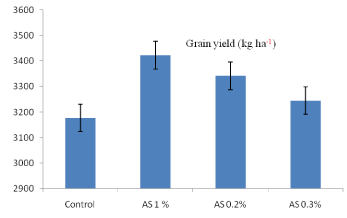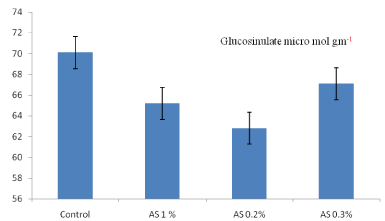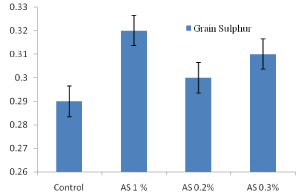
Rapid Communication
Austin Food Sci. 2016; 1(6): 1026.
Effect of Ammonium Sulphate Foliar Spray on Grain Yield and Yield Quality of Canola
Nawab Ali*, Anjum MM and Afridi MZ
Department of Agronomy, University of Agriculture Peshawar, Pakistan
*Corresponding author: Nawab Ali, Department of Agronomy, University of Agriculture Peshawar, Pakistan; Email: nawab@aup.edu.pk
Received: September 26, 2016; Accepted: November 01, 2016; Published: November 09, 2016
Abstract
The experiment entitle “Effect of Ammonium Sulphate Foliar Spray on Grain Yield And Yield Quality of Canola” was conducted at the Palatoo Research farm Department of Agronomy, Amir Muhammad Khan Campus, Mardan during rabi season 2014-15. The treatments consist of Ammonium Sulphate (AS) 1%, 0.2%, 0.3% solution and water spray as control. The experiment layed out in randomized complete block design with four replications. The results indicated that application of 1% AS improved grain yield 3177 (control) to 3423 (treated), oil content 42.3% (control) to 45.7% (treated), gluccosinulates 65.2 micro mol gm-1 (control) to 70.1 micro mol gm-1 (treated), protein content 23.1% (control) to 23.6% (treated), grain Sulphur % 0.29 (control) to 0.32 (treated) and grain nitrogen %3.35 (control) to 3.89% of (treated). The application of AS 0.2% produced grain yield (3342 kg ha-1) oil content (43.2%) gluccosinulates (62.8micro mol gm-1) protein content (23.4%) grain Sulphur (0.30%) and grain nitrogen (3.11%). While the application of AS 0.3% produced grain yield (3245 kg ha-1) oil content (44.2%) gluccosinulates (67.1 micro mol gm-1) protein content (2.5%) grain Sulphur (0.31%) and grain nitrogen (3.0%). Therefore on the basis of this research at 1% AS is suggested for application on canola to improve its grain yield and yielding quality components.
Keywords: Canola; Amonium sulphate; Oil content; Yield quality
Introduction
Rapeseed (Brassica napus L.) belongs to the Cruciferae family the common species are Nigra, Carinata, juncea, oleracea and compestries [1]. Rapeseed or mustard was grown from 300 Bc in Indus valley of Pakistan as a fodder crop. Rapeseed and mustard are traditional oil seed crops of Pakistan are grown in large area of four provinces of country [2]. Canola was introduced in Pakistan during 1995 for general cultivation to replace traditional oilseed crops like rapes and mustards because of its low erucic acid contents and high yielding capacity [3]. During 2011-12 in Pakistan the Canola crop was cultivated 14700 ha with the production of 7000 tones, while Khyber Pakhtunkhwa the area under cultivation was 1300 ha with a total production of 1800 tones [4].
Like all other crops, growth, developmental process and grain yield of canola depends upon biotic and a biotic factors. Sulfur is the fourth major plant nutrient after nitrogen, phosphorus and potassium. It is essential for synthesis of the amino acids like cystine and methionine, a component of vitamin A and activates certain enzyme systems in plants [5]. Edible oil is one of the basic requirements of our daily diet [6]. Pakistan is suffering from acute deficiency in edible oil because of its increased consumption. The total availability of edible oil was 2.821 million tons. Local production of edible oil stood at 0.68 million tons, which is 24 percent of the total availability in the country. Sulphur has been reported to influence productivity of oil seed [7].
Sulphur also plays an important role in the chemical composition of seed. Sulphur increases the percentage of oil content of the seed [3] and glucosinolate content [8]. Glucosinolates are a group of secondary metabolites containing β-thioglucose, a sulphonated oxime moiety and a side chain, their concentration is closely related to the S supply, what is not surprising, since each glucosinolate molecule contains two or three S atoms [9]. Sulphur supply has not only an impact on the total concentration of glucosinolates in the rapeseeds, but also on the relative proportions on the individual glucosinolates. Due to interactions between S and S influence of the S nutritional status of rape on glucosinolate synthesis should always be considered along with the N supply.
Keep in view the importance of ammonium sulphate present research was conducted in order to study the response of canola to different application of foliar spray on canola.
With objectives to determine the effects of foliar application ammonium sulphate (1%, 0.2% and 0.3%) on canola grain yield and its quality yield components.
Material and Methods
The Experiment entitled “impact of ammonium sulphate foliar spray on canola yield and yielding components” was conducted at the Palatoo research farm of Agronomy, Amir Muhmmad khan Campus, Mardan during Rabi season 2014-2015. The experiment consists of ammonium sulphate levels (1%, 0. 2% and 0.3%) and water spray. The Experiment was laid out in randomized complete block, having four replication. The plot size was 2×2 m². Ploughing was done with help of cultivator and crop sown. The Basel dose N and P @ 70 and 40 kg-1 ha applied respectively. Hoeing was carried out after rosette stage to control weeds. All the agronomic practices were applied according to crop need.
Amonium sulphate
Grain yield (kg ha-1)
oil content %
Gluccosinulates (micro mol gram-1)
protein content %
Grains Sulphur Content %
Grains Nitrogen Content %
Control
3177
42.3
70.1
23.1
0.29
3.35
AS 1%
3423
45.7
65.2
23.6
0.32
3.89
AS 0.2%
3342
43.2
62.8
23.4
0.3
3.11
AS 0.3%
3245
44.2
67.1
23.5
0.31
3.22
LSD
2.27
2.23
0.54
0.23
0.26
0.22
Table 1: Effects of different levels of ammonium sulphate foliar application on the measured indexes of Canola.
The treatments were as follow
Treatments Ammonium sulphate doses
T1 = Water spray only
T2 = 0.2%
T3 = 0.3%
T4 = 1%
Grain yield (kg ha-1)
The Data regarding on grain yield plot-1 presented in (Figure 1). Statistical analysis shows that there is a significant affect in grain yield due to ammonium sulphate foliar application on canola. More grain yield (3423 kg ha-1) was obtained with the application of 1% ammonium sulphate as compare to control (3177 kg ha-1), 0.2% (3342 kg ha-1) and 0.3% (3245 kg ha-1) solution. The result is also in agreement with the findings of [10] having been reported that increasing levels of sulphur solution increased grains yield. Canola which is an oil seed crop response positively to sulphur application due to which its grain yield increases [11].

Figure 1: Effect of ammonium sulphate foliar spray on grain yield (kg ha-1)
of canola.
Oil content (%)
The Data regarding of oil content presented in (Figure 2). Statistical analysis shows that there is a significant difference in the oil content due to ammonium sulphate foliar application on canola. More oil content (45.7%) were obtained with the application of 1% ammonium sulphate as compare to control (42.3%), 0.2% (43.2%) and 0.3% (44.2%). The result are also in agreement with the findings of that canola as an oil seed crop response more positively to sulphur solution so increase in sulphur rate more oil content can be obtained and [12].

Figure 2: Effect of ammonium sulphate foliar spray on oil content (%) of
canola.
Gluccosinulates (micro mol g-1)
The Data regarding on gluccosinulates in canola presented in (Figure 3). Statistical analysis shows that there is a significant difference in the content of gluccosinulates due to ammonium sulphate foliar application on canola. More gluccosinulates (70.1 micro mol g-1) were obtained with the application of 1% ammonium sulphate as compare to control (65.2 micro mol g-1), 0.2% (62.8 micro mol g-1) and 0.3% (67.1 micro mol g-1). The result is also in agreement with the findings of. Canola as an oil seed crop response more positively to sulphur solution so increase in sulphur rate more gluccosinulates content can be obtained.

Figure 3: Effect of ammonium sulphate foliar spray on glucosinulates content
(%) of canola.
Protein content (%)
The Data regarding on protein content in canola presented in (Figure 4). Statistical analysis shows that there is a significant difference in the content of protein content due to ammonium sulphate foliar application on canola. More protein content (23.6%) were obtained with the application of 1% ammonium sulphate as compare to control (23.1%), 0.2% (23.4%) and 0.3% (23.5%). The result is also in agreement with the findings of. Canola as an oil seed crop response more positively to sulphur solution so increase in sulphur rate more protein content can be obtained.

Figure 4: Effect of ammonium sulphate foliar spray on protein content (%)
of canola.
Grain sulphur (%)
The Data regarding on grain sulphur (%) in canola presented in (Figure 5). Statistical analysis shows that there were not significant differences in the content of sulphur in grains due to ammonium sulphate foliar application on canola. More grain sulphur content (0.32%) were obtained with the application of 1% ammonium sulphate as compare to control (0.29%), 0.2% (0.30%) and 0.3% (0.31%). The results are also in agreement with the statistically data showed no significant but sulphur content in grain can be obtained more due to high application of ammonium sulphate.

Figure 5: Effect of ammonium sulphate foliar spray on grain sulphur content
(%) of canola.
Grain nitrogen (%)
The Data regarding on grain nitrogen (%) in canola presented in (Figure 6). Statistical analysis shows that there were not significant differences in the content of nitrogen in grains due to ammonium sulphate foliar application on canola. More grain nitrogen content (3.89%) were obtained with the application of 1% ammonium sulphate as compare to control (3.35%), 0.2% (3.11%) and 0.3% (3.0%). The results are also in agreement with the statistically data showed no significant but nitrogen content in grain can be obtained more due to high application of ammonium sulphate.

Figure 6: Effect of ammonium sulphate foliar spray on grain Nitrogen content
(%) of canola.
Conclusion
It is concluded from the present findings that foliar application of ammonium sulphate @ 1% significantly increased the yield and quality attributes of canola.
References
- Holmes MRJ. In Nutrition of the oilseed rape crop. Nitrogen. 1980; 21-67.
- Khan AH, Khalil IA, Shah H. Nutritional yield and oil quality of canola cultivars grown in NWFP. Sarhad J Agric. 2004; 20: 287-290.
- Chaudhary SK, Gogulwar NM, Singh AK. Effect of sulphur and nitrogen on seed yield and oil content of mustard (Brassica juncea). Indian J Agron. 1992; 37: 839-840.
- MNFSR. The Statistics Government of Pakistan Ministry of Food Security and Research Islamabad. 2012.
- Havlin JL, Beaton JD, Tisdale SL, Nelson WL. Soil fertility and fertilizers. An introduction to nutrient management 7th edn. Pearson Education Inc Singapore. 2004; 221.
- Downey RK, Rimmer SR. Agronomic improvement in oilseed Brassica. Adv Agron. 1994; 50: 1-66.
- Singh B, Singh J, Kumar A, Yadav YP, Singh S. Response of Brassica to sulphur for yield. Ind J Agric Sci. 1999; 69: 427-431.
- Marschner H. Mineral Nutrition of Higher Plants. Academic Press Inc London. 1986.
- Zhao FJ, Withers PJA, Evans EJ, Monaghan J, Salmon SE, Shewry PR. Sulphur nutrition: An important factor for the quality of wheat and rapeseed. 1997.
- Sharifi RS. Sulphur fertilizer effects on grain yield and the sum of physiological indices of canola (brassica napus) L (Annals of biological research). 2012; 3: 5034-5041.
- Malik MA, Aziz I, Khan HZ, Wahid MA. Growth, seed yield and oil content response of Canola (Vrassica napus L.) to Varying levels of sulphur. Int J Agri Biol. 2004; 6: 1153-1155.
- Vaseghi S, Valinejad, Afazali M. Yield, seed quality and sulphur uptake of brassica oilseed crops in response to sulphur fertilization. World of science journal. 2011; 1: 163-172.